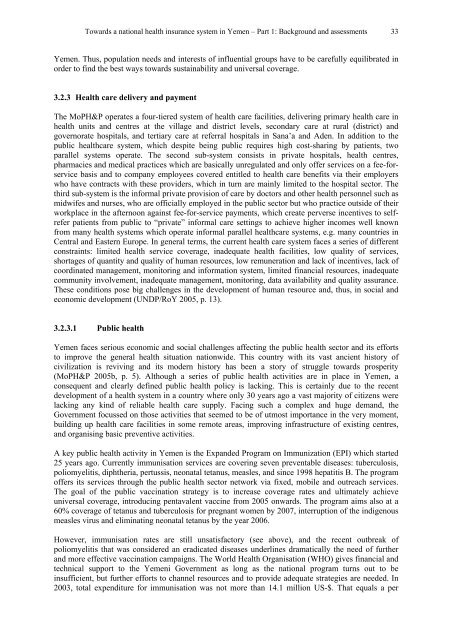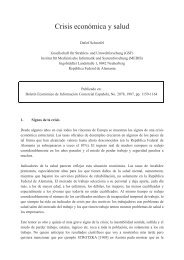Towards a national health insurance system in ... - Detlef Schwefel
Towards a national health insurance system in ... - Detlef Schwefel
Towards a national health insurance system in ... - Detlef Schwefel
You also want an ePaper? Increase the reach of your titles
YUMPU automatically turns print PDFs into web optimized ePapers that Google loves.
<strong>Towards</strong> a <strong>national</strong> <strong>health</strong> <strong><strong>in</strong>surance</strong> <strong>system</strong> <strong>in</strong> Yemen – Part 1: Background and assessments 33<br />
Yemen. Thus, population needs and <strong>in</strong>terests of <strong>in</strong>fluential groups have to be carefully equilibrated <strong>in</strong><br />
order to f<strong>in</strong>d the best ways towards susta<strong>in</strong>ability and universal coverage.<br />
3.2.3 Health care delivery and payment<br />
The MoPH&P operates a four-tiered <strong>system</strong> of <strong>health</strong> care facilities, deliver<strong>in</strong>g primary <strong>health</strong> care <strong>in</strong><br />
<strong>health</strong> units and centres at the village and district levels, secondary care at rural (district) and<br />
governorate hospitals, and tertiary care at referral hospitals <strong>in</strong> Sana’a and Aden. In addition to the<br />
public <strong>health</strong>care <strong>system</strong>, which despite be<strong>in</strong>g public requires high cost-shar<strong>in</strong>g by patients, two<br />
parallel <strong>system</strong>s operate. The second sub-<strong>system</strong> consists <strong>in</strong> private hospitals, <strong>health</strong> centres,<br />
pharmacies and medical practices which are basically unregulated and only offer services on a fee-forservice<br />
basis and to company employees covered entitled to <strong>health</strong> care benefits via their employers<br />
who have contracts with these providers, which <strong>in</strong> turn are ma<strong>in</strong>ly limited to the hospital sector. The<br />
third sub-<strong>system</strong> is the <strong>in</strong>formal private provision of care by doctors and other <strong>health</strong> personnel such as<br />
midwifes and nurses, who are officially employed <strong>in</strong> the public sector but who practice outside of their<br />
workplace <strong>in</strong> the afternoon aga<strong>in</strong>st fee-for-service payments, which create perverse <strong>in</strong>centives to selfrefer<br />
patients from public to “private” <strong>in</strong>formal care sett<strong>in</strong>gs to achieve higher <strong>in</strong>comes well known<br />
from many <strong>health</strong> <strong>system</strong>s which operate <strong>in</strong>formal parallel <strong>health</strong>care <strong>system</strong>s, e.g. many countries <strong>in</strong><br />
Central and Eastern Europe. In general terms, the current <strong>health</strong> care <strong>system</strong> faces a series of different<br />
constra<strong>in</strong>ts: limited <strong>health</strong> service coverage, <strong>in</strong>adequate <strong>health</strong> facilities, low quality of services,<br />
shortages of quantity and quality of human resources, low remuneration and lack of <strong>in</strong>centives, lack of<br />
coord<strong>in</strong>ated management, monitor<strong>in</strong>g and <strong>in</strong>formation <strong>system</strong>, limited f<strong>in</strong>ancial resources, <strong>in</strong>adequate<br />
community <strong>in</strong>volvement, <strong>in</strong>adequate management, monitor<strong>in</strong>g, data availability and quality assurance.<br />
These conditions pose big challenges <strong>in</strong> the development of human resource and, thus, <strong>in</strong> social and<br />
economic development (UNDP/RoY 2005, p. 13).<br />
3.2.3.1 Public <strong>health</strong><br />
Yemen faces serious economic and social challenges affect<strong>in</strong>g the public <strong>health</strong> sector and its efforts<br />
to improve the general <strong>health</strong> situation nationwide. This country with its vast ancient history of<br />
civilization is reviv<strong>in</strong>g and its modern history has been a story of struggle towards prosperity<br />
(MoPH&P 2005b, p. 5). Although a series of public <strong>health</strong> activities are <strong>in</strong> place <strong>in</strong> Yemen, a<br />
consequent and clearly def<strong>in</strong>ed public <strong>health</strong> policy is lack<strong>in</strong>g. This is certa<strong>in</strong>ly due to the recent<br />
development of a <strong>health</strong> <strong>system</strong> <strong>in</strong> a country where only 30 years ago a vast majority of citizens were<br />
lack<strong>in</strong>g any k<strong>in</strong>d of reliable <strong>health</strong> care supply. Fac<strong>in</strong>g such a complex and huge demand, the<br />
Government focussed on those activities that seemed to be of utmost importance <strong>in</strong> the very moment,<br />
build<strong>in</strong>g up <strong>health</strong> care facilities <strong>in</strong> some remote areas, improv<strong>in</strong>g <strong>in</strong>frastructure of exist<strong>in</strong>g centres,<br />
and organis<strong>in</strong>g basic preventive activities.<br />
A key public <strong>health</strong> activity <strong>in</strong> Yemen is the Expanded Program on Immunization (EPI) which started<br />
25 years ago. Currently immunisation services are cover<strong>in</strong>g seven preventable diseases: tuberculosis,<br />
poliomyelitis, diphtheria, pertussis, neonatal tetanus, measles, and s<strong>in</strong>ce 1998 hepatitis B. The program<br />
offers its services through the public <strong>health</strong> sector network via fixed, mobile and outreach services.<br />
The goal of the public vacc<strong>in</strong>ation strategy is to <strong>in</strong>crease coverage rates and ultimately achieve<br />
universal coverage, <strong>in</strong>troduc<strong>in</strong>g pentavalent vacc<strong>in</strong>e from 2005 onwards. The program aims also at a<br />
60% coverage of tetanus and tuberculosis for pregnant women by 2007, <strong>in</strong>terruption of the <strong>in</strong>digenous<br />
measles virus and elim<strong>in</strong>at<strong>in</strong>g neonatal tetanus by the year 2006.<br />
However, immunisation rates are still unsatisfactory (see above), and the recent outbreak of<br />
poliomyelitis that was considered an eradicated diseases underl<strong>in</strong>es dramatically the need of further<br />
and more effective vacc<strong>in</strong>ation campaigns. The World Health Organisation (WHO) gives f<strong>in</strong>ancial and<br />
technical support to the Yemeni Government as long as the <strong>national</strong> program turns out to be<br />
<strong>in</strong>sufficient, but further efforts to channel resources and to provide adequate strategies are needed. In<br />
2003, total expenditure for immunisation was not more than 14.1 million US-$. That equals a per

















